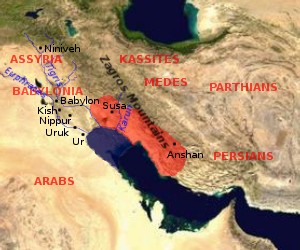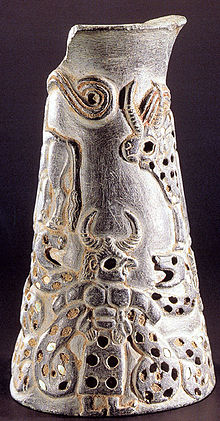Elamite Empire

The Iranian Plateau did not experience the rise of urban, literate civilization in the late 4th and early 3rd millennia on the Mesopotamian pattern but the lowland Khuzestan did. It was the Elamite Civilization.Geographically, Elam included more than Khuzestan; it was a combination of the lowlands and the immediate highland areas to the north and east. Elamite strength was based on an ability to hold these various areas together under a coordinated government that permitted the maximum interchange of the natural resources unique to each region. Traditionally this was done through a federated governmental structure.
Iran Before the Elamites
Closely related to that form of government was the Elamite system of inheritance and power distribution. The normal pattern of government was that of an overlord ruling over vassal princes. In earliest times the overlord lived in Susa, which functioned as a federal capital. With him ruled his brother closest in age, the viceroy, who usually had his seat of government in the native city of the currently ruling dynasty. This viceroy was heir presumptive to the overlord. Yet a third official, the regent or prince of Susa (the district), shared power with the overlord and the viceroy. He was usually the overlord's son or, if no son was available, his nephew. On the death of the overlord, the viceroy became overlord. The prince of Susa remained in office, and the brother of the old viceroy nearest to him in age became the new viceroy. Only if all brothers were dead was the prince of Susa promoted to viceroy, thus enabling the overlord to name his own son (or nephew) as the new prince of Susa. Such a complicated system of governmental checks, balances, and power inheritance often broke down despite bilateral descent and levirate marriage (i.e., the compulsory marriage of a widow to her deceased husband's brother). What is remarkable is how often the system did work; it was only in the Middle and Neo-Elamite periods that sons more often succeeded fathers to power.

The Art of Elamites
Elamite history can be divided into three main phases: the Old, Middle, and Late, or Neo-Elamite, periods. In all periods Elam was closely involved with Sumer, Babylonia, and Assyria, sometimes through peaceful trade, more often through war. In like manner, Elam was often a participant in events on the Iranian Plateau. Both involvements were related to the combined need of all the lowland civilizations to control the warlike peoples to the east and to exploit the economic resources of the plateau.
Old Elamite Period
The earliest kings in the Old Elamite period may date to approximately 2700 BCE. Already conflict with Mesopotamia, in this case apparently with the city of Ur, was characteristic of Elamite history. These early rulers were succeeded by the Awan (Shustar) dynasty.
The 11th king of this line entered into treaty relations with the great Naram-Sin of Akkad (c. 2254 - c. 2218 BCE). Yet there soon appeared a new ruling house, the Simash dynasty (Simash may have been in the mountains of southern Luristan). The outstanding event of this period was the virtual conquest of Elam by Shulgi of the 3rd dynasty of Ur (c. 2094 - c. 2047 BCE). Eventually the Elamites rose in rebellion and overthrew the 3rd Ur dynasty, an event long remembered in Mesopotamian dirges and omen texts. About the middle of the 19th century BCE, power in Elam passed to a new dynasty, that of Eparti. The third king of this line, Shirukdukh, was active in various military coalitions against the rising power of Babylon, but Hammurabi (c. 1792 - c. 1750 BCE) was not to be denied, and Elam was crushed in 1764 BCE. The Old Babylon kingdom, however, fell into rapid decline following the death of Hammurabi, and it was not long before the Elamites were able to gain revenge. Kutir-Nahhunte I attacked Samsuiluna (c. 1749 - c. 1712 BCE), Hammurabi's son, and dealt so serious a defeat to the Babylonians that the event was remembered more than 1,000 years later in an inscription of the Assyrian king Ashurbanipal. It may be assumed that with this stroke Elam once again gained independence. The end of the Eparti dynasty, which may have come in the late 16th century BCE, is buried in silence.
Middle Elamite Period
After two centuries for which sources reveal nothing, the Middle Elamite period opened with the rise to power of the Anzanite dynasty, whose homeland probably lay in the mountains northeast of Khuzestan. Political expansion under Khumbannumena (c. 1285 - c. 1266 BCE), the fourth king of this line, proceeded apace, and his successes were commemorated by his assumption of the title "Expander of the Empire." He was succeeded by his son, Untash-Gal (Untash (d) Gal, or Untash-Huban), a contemporary of Shalmaneser I of Assyria (c. 1274 - c. 1245 BCE) and the founder of the city of Dur Untash (modern Chogha Zanbil).
In the years immediately following Untash-Gal, Elam increasingly found itself in real or potential conflict with the rising power of Assyria. Tukulti-Ninurta I of Assyria (c. 1244 - c. 1208 BCE) campaigned in the mountains north of Elam. The Elamites under Kidin-Khutran, second king after Untash-Gal, countered with a successful and devastating raid on Babylonia.In the end, however, Assyrian power seems to have been too great. Tukulti-Ninurta managed to expand, for a brief time, Assyrian control well to the south in Mesopotamia, Kidin-Khutran faded into obscurity, and the Anzanite dynasty came to an end.
The Art of Elamites
After a short period of dynastic troubles, the second half of the Middle Elamite period opened with the reign of Shutruk-Nahhunte (c. 1160 BCE). Two equally powerful and two rather less impressive kings followed this founder of a new dynasty, whose home was probably Susa, and in this period Elam became one of the great military powers of the Middle East. Tukulti-Ninurta died about 1208 BC, and Assyria fell into a period of internal weakness and dynastic conflict. Elam was quick to take advantage of this situation by campaigning extensively in the Diyala River area and into the very heart of Mesopotamia. Shutruk-Nahhunte captured Babylon and carried off to Susa the stela on which was inscribed the famous law code of Hammurabi. Shilkhak-In-Shushinak, brother and successor of Shutruk-Nahhunte's eldest son, Kutir-Nahhunte, still anxious to take advantage of Assyrian weakness, campaigned as far north as the area of modern Kirkuk. In Babylonia, however, the 2nd dynasty of Isin led a native revolt against such control as the Elamites had been able to exercise there, and Elamite power in central Mesopotamia was eventually broken. The Elamite military empire began to shrink rapidly. Nebuchadrezzar I of Babylon (c. 1124 - c. 1103 BCE) attacked Elam and was just barely beaten off. A second Babylonian attack succeeded, however, and the whole of Elam was apparently overrun, ending the Middle Elamite period.
It is noteworthy that during the Middle Elamite period the old system of succession to, and distribution of, power appears to have broken down. Increasingly, son succeeded father, and less is heard of divided authority within a federated system. This probably reflects an effort to increase the central authority at Susa in order to conduct effective military campaigns abroad and to hold Elamite foreign conquests. The old system of regionalism balanced with federalism must have suffered, and the fraternal, sectional strife that so weakened Elam in the Neo-Elamite period may have had its roots in the centrifugal developments of the 13th and 12th centuries BCE.
Neo-Elamite Period
A long period of darkness separates the Middle and Neo-Elamite periods. In 742 BCE a certain Huban-nugash is mentioned as king in Elam. The land appears to have been divided into separate principalities, with the central power fairly weak.The next 100 years witnessed the constant attempts of the Elamites to interfere in Mesopotamian affairs, usually in alliance with Babylon, against the constant pressure of Neo-Assyrian expansion. At times they were successful with this policy, both militarily and diplomatically, but on the whole they were forced to give way to increasing Assyrian power. Local Elamite dynastic troubles were from time to time compounded by both Assyrian and Babylonian interference. Meanwhile, the Assyrian army whittled away at Elamite power and influence in Luristan. In time these internal and external pressures resulted in the near total collapse of any meaningful central authority in Elam. In a series of campaigns between 692 and 639 BCE, in an effort to clean up a political and diplomatic mess that had become a chronic headache for the Assyrians, Ashurbanipal's armies utterly destroyed Susa, pulling down buildings, looting, and sowing the land of Elam with salt.
.....
.....
.....

.jpg)



























